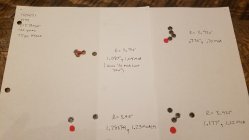I'm relatively new to tuning rifles to have great accuracy. I have a 300 win shooting 215 bergers with 75 grains of H1000 at 2740 fps. For the past couple years it has been a half minute rifle. This year it has gone out of tune and is shooting about 1.1 moa. What is the best approach to finding the tune again?
My first guess is to chase the lands - they are probably wearing by now. So I loaded up a few rounds with the same powder charge and started seating the bullets longer in .005" increments. You can see in the photo below that things didn't improve. I'm confident that the fliers in the original load are not my fault. I have shot a lot of shots with it since it has gone out of tune and seen many fliers on shots which feel solid.
What would you try next? I almost feel like I should go shorter with the OAL, since the original load still shows so much promise. Maybe vary the powder charge slightly?
I've also thought about playing around the 3.920" length, but I would need to shoot quite a few more rounds to confirm that load is indeed in the .7 moa ballpark; it could very easily open up to 1.25 moa with another shot.
What would you do from here?
Thanks!

My first guess is to chase the lands - they are probably wearing by now. So I loaded up a few rounds with the same powder charge and started seating the bullets longer in .005" increments. You can see in the photo below that things didn't improve. I'm confident that the fliers in the original load are not my fault. I have shot a lot of shots with it since it has gone out of tune and seen many fliers on shots which feel solid.
What would you try next? I almost feel like I should go shorter with the OAL, since the original load still shows so much promise. Maybe vary the powder charge slightly?
I've also thought about playing around the 3.920" length, but I would need to shoot quite a few more rounds to confirm that load is indeed in the .7 moa ballpark; it could very easily open up to 1.25 moa with another shot.
What would you do from here?
Thanks!












